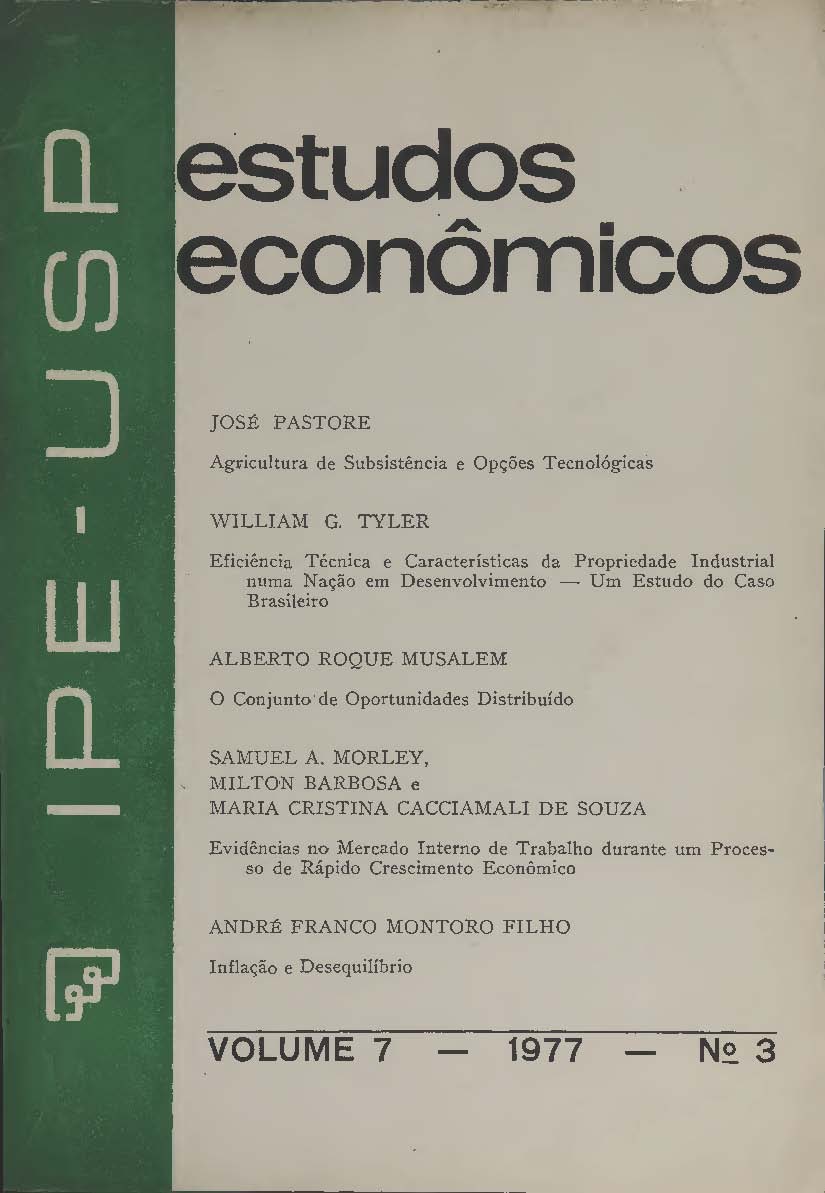Inflação e desequilíbrios
Resumo
A análise tradicional de inflação apresentando-a como fenômeno puramente agregado nos parece extremamente artificial. Argumentamos que a inflação é basicamente um processo distributivo gerado pela necessidade e/ou aspirações tanto de mudanças de poder aquisitivo entre setores quanto de transferências de fatores entre diversos setores. Apresentamos neste trabalho uma formulação analítica na qual a partir de desajustes setoriais é possível explicar mudanças nos níveis gerais de preços. Argumentamos que, havendo inflexibilidade dos preços para baixo, ou ao menos assimetria na respoata a excessos de demanda e de oferta, o processo de realocação de fatores entre os diversos setores gerará pressões inflacionárias. (Em outras palavras, as modificaçõoes de preços relativos são acompanhadas por elevações no nível geral de preços.
Downloads
Referências
BAILEY, M. — Welfare Cost of Inflationary Finance, Journal of Political Economy, abril, 1956.
BARRO, R. J. — A Theory of Monopolistic Price Adjustment, Review of Economic Studies, 39 (1), 1972.
FISCHER, I. — A Statistical Relation Bletween Unemployment and Prices Changes, International Labour Review, 1926; reeld. «I discovered the Phillips Curve», Journal of Political Economy, 81 (2), 1973.
FRIEDMAN, Milton — The Role of Monetary Policy, The American Economic Review, vol. 58. margo, 1968.
FRIEDMAN, Milton — The Quantity Theory of Money — A Restatement, in Milton Friedman, ed. — Studies in the Quantity Theory of Money, 1956.
GORDON, R.J. — Recent Developments in the Theory of Inflation and Unemployment, Journal of Monetary Economics, (2), 1976.
HICKS, John — The Crisis in Keynesian Economics, Nova York: 1974.
HERSOHMAN, A.O. — Exit, Voice and Loyalty, Harvard: 1970.
JONHSON, H. — A Survey of Theories of Inflation^, in Harry Johnson, Essay in Monetary Economics, 2.a ed., 1969.
KESSEL, R. e A. ALCHIAN — Effects of Inflation. Journal of Political Economy, dez, 1962.
LAIDLER, D. e M. PARKIN — Inflation; A Survey, The Economic Journal, (85), dez. 1975.
LIPSEY, R. — The Relation between Unemployment and the Rate of Change of Mjoney Wage Rates in the U.K. 1862-1957: A Further Analysis, Economica, vol. 27, 1960.
MODIGLIANI F. — The Monetarist Controversy or Should We Forsake Stabilization Policies?, The American Economic Review, 67, (2), março, 1977.
NORDHAUS, W. — Recent Developments in Price Dynamics, in O. Eckstein (ed). — The Eoonometrics of Price Determination Conference, Federal Reserve Board: 1972.
OKUN, A.M. — Inflation: its Mechanics and Welfare Costs, Breakings Paper on Economic Activity, 6, (2), 1975.
PHELPS, EjS. (ed). — Microeconomic Foundations of Employment and Inflation Theory* Nova York: 1970.
PHELPS, EjS. — Phillips Curve, Expectations of Inflation and Optimal Unemployment over Time, EoOnomica, vol. 34, 1967.
PHELPS, E.S. e S. WINTER — Optimal Price Policy under Atomistic Competition, in Phellps (ed). — Op. Cit. [16].
PHILLIPS, A.W. — The Relation Between Unemployment and the Rate of Change of Money Wage Rates in the U.K. 1861-1957, Economica, vol. 25, 1958.
SALOP, S. e J. STIGLITZ — A Frameworic for Analysing Monopolistically Competitive Price Dispersion, Special Studies Paper nº 95, Federal Reserve Board: jul. 1977.
SCHULTZE, C.L. — Recent Inflation in the United States, Study Paper, nº 1 for Joint Economic Committee, Washington: 1959.
TOBIN, James — Inflation and Unemployment, The American Economic Review, 62 (1), 1972.
TOBIN, James — ((Unemployment and Inflation», (mimeoH Yale University, Spring Term, 1972.
Downloads
Publicado
Edição
Seção
Licença
Copyright (c) 1977 Estudos Econômicos (São Paulo)

Este trabalho está licenciado sob uma licença Creative Commons Attribution-NonCommercial 4.0 International License.
A submissão de artigo autoriza sua publicação e implica o compromisso de que o mesmo material não esteja sendo submetido a outro periódico.
A revista não paga direitos autorais aos autores dos artigos publicados.
O detentor dos direitos autorais da revista é o Departamento de Economia da Faculdade de Economia, Administração, Contabilidade e Atuária da Universidade de São Paulo.




